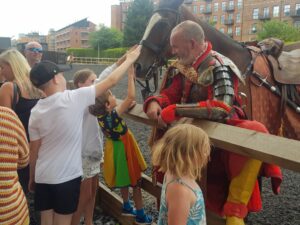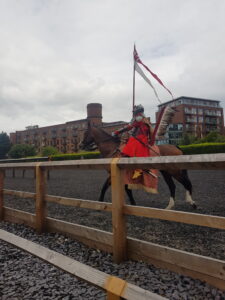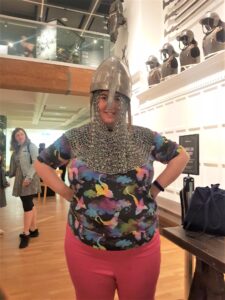The Royal Armouries examines how arms and armour have shaped society, art, and culture throughout history. The museum was opened to the public 1996 and stores a huge collection of arms & armour that was originally housed in the Tower of London. It is a completely free museum to enter and is geared towards families with children of all ages. Most of the on-gallery interpretation is at child height which helps them not feel left out.
There are 5 main galleries: War, Oriental, Tournament, Hunting (currently undergoing refurbishment) and Self-defence. The hall of steel, a towering display of weapons, runs up alongside every level of the museum as a center piece of the main staircase.
Adjacent to the main building is an outdoor arena where horseback combat and gun firing demonstrations take place. During my visit, along with my partner and our niece and nephew, aged 10 and 6, I found some examples of good practice that relate to our engagement reflection points.
Build confidence and ownership
On entry to the museum, we were greeted by a friendly and welcoming member of staff who informed us of what shows and demonstrations were taking place, where they were and at what times. This friendly welcome got the visit off to a great start and made us feel welcome in the museum.
A very striking feature of the grand entrance hall is a floor to ceiling timeline, showing the development of armour and weapons from 1000BCE all the way up to the present day. Visually striking, colourful and easily readable for younger visitors, this interpretation really sets the contents of the museum in context right from the start of the visit.
There is good use of digital content with screens at regular points around the galleries showing films to give wider context to the conflicts and time periods showcased in the gallery. Some of these have interpretation in British Sign Language and the museum is committed to including this for all their digital displays in the future.
There are some fun interactives- my favourite was digital display masks, place at heights which allow both adults and small children to access them. These masks show you the horror of a medieval battle through the restrictive view of a full-face helmet. This helped demonstrate an experience that would be difficult to explain and imagine otherwise.
The 6-year-old with us enjoyed handling some medieval weapons (thankfully they were firmly secured to the wall) and learning about the gruesome damage they were capable of inflicting.
Promote science talk
There are a number of free live demonstrations every day, located in performance spaces in each of the major galleries and in the outdoor arena.
in the outdoor arena.
We saw a demonstration of knights in combat with a pole axe in the Tournament gallery and watched a show in the outdoor arena showcasing cavalry riders from different eras and the weapons they used. This large scale family friendly half hour live show is also completely free. You could plan one of these into a family day out in Leeds without even visiting the main museum if you wanted to.
These demonstrations prompted some great conversations, like whether it would be better to live in medieval times or the present day and what skills you needed to build armour that would keep you safe! These conversations are not only great for promoting good discussions within the museum itself, but they continued long after we’d left.
I really liked how the indoor performance spaces were right in the middle of the galleries. In a lot of museums performance spaces take place in a hidden room (often out of sight, out of mind).
With the performance spaces being right in the middle of the gallery even if you weren’t aware of the show times in advance it would be very easy to stumble upon a demo as you didn’t have to seek them out.
 After the shows at least one of the performers stayed behind to directly engage with visitors- allowing them to handle the weapons, have pictures and selfies taken and generally chat and answer questions. Getting to meet and stroke the horses was the 10-year-olds highlight of the day!
After the shows at least one of the performers stayed behind to directly engage with visitors- allowing them to handle the weapons, have pictures and selfies taken and generally chat and answer questions. Getting to meet and stroke the horses was the 10-year-olds highlight of the day!
Regular object handling sessions in different galleries throughout the day give visitors the chance to touch and even try on authentic pieces of armour. These interactions are carried out by staff and volunteers who were very knowledgeable and good at engaging visitors of different age groups.
They spoke to the 6-year-old on his level, using open questions and employing positive reinforcement so that he could then play the expert, telling his sister all about what he’d learnt.
Use everyday examples
The Make:Believe exhibit is a collection of fictional weapons and armaments made up mostly of props from famous movies. For example, you could see Darth Vader’s helmet alongside some of the historical headgear – including that of a medieval knight and a Japanese samurai- that inspired it.
For example, you could see Darth Vader’s helmet alongside some of the historical headgear – including that of a medieval knight and a Japanese samurai- that inspired it.
You can also see Bilbo Baggins’ sword ‘Sting’ alongside examples of historical swords that influenced its design.
This gallery really hits a number of the reflection points, helping visitors to feel like an expert, building on their existing knowledge by providing STEM content through the lens of beloved movies that most people are familiar with.
The exhibit also broadens perceptions through telling the stories of movie prop makers, allowing those with craft skills & interests to consider STEM careers in the arts that they may not have been aware of before.
Extend the Experience
The museum’s website hosts a wide range of digital resources to help visitors extend their experience beyond the museum walls. It is divided up into sections covering all of the time periods highlighted in the museum’s collection.
There are very informative and fun videos on everything from the life in a ‘pals battalion’ in World War 1 to the adventures of a Viking shield maiden! Learning guides are available to download for teachers planning to bring school groups to the museum.
My personal favourite online resource is Time Travel Radio. These are short and snappy custom-made audio dramas, giving an on-the-ground view of history. For example, you can hear an interview with Tiberius, a roman soldier stationed at Hadrian’s Wall or listen to Grendel’s mum giving her side of the story of her battle with Beowulf.
The Royal Armouries creates an experience where adults and little ones alike can explore the STEM topics of today through the lens of the past. The use of everyday examples gives visitors a sense of ownership and allows families to talk about the science behind history.
What to read next
If you have enjoyed this ‘out-and-about’ blog here are others on a similar topic we think you will also enjoy.
Have you visited the Royal Armouries before? Let us know your thoughts below.
In our ‘out and about‘ series we go searching for examples of good STEM engagement practice. Have you visited anywhere which demonstrates good STEM engagement practice.